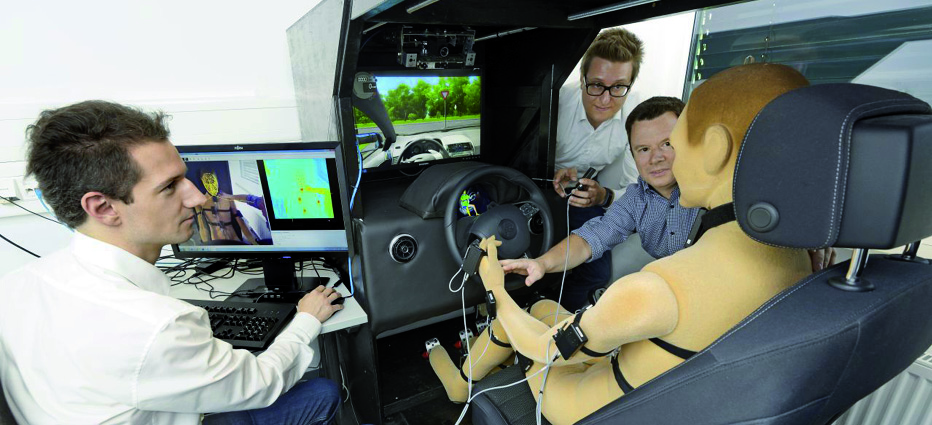
Henning Metzmacher takes a seat in the driving simulator and pushes a few buttons.
A few seconds later, his silhouette can be seen on a computer screen. This image is created by an infrared camera, which makes the temperature distribution within his body visible. The head is colored light orange, the arms and the upper body are colored in shades of green. This means that he feels comfortable.
Dr. Daniel Wölki takes a look at another computer screen: “This is the image generated by MORPHEUS, a numerical model of the human body. This simulated image almost exactly represents the real one, as gesture tracking makes it possible for us to assign body regions to image and sensor data.”
Improving the Range of Electric Cars
Wölki is head of the “Thermal Ergonomics and User Behavior” research group at the Institute of Energy Efficiency and Sustainable Building, E3D. At the Institute, headed by Professor Christoph van Treeck, IT specialists as well as medical, electrical, and control engineers collaborate on novel climate control technologies for electric vehicles.
“Heating and climate control, as the main on-board electric consumers, reduce the range of an electric car by about fifty percent,” explained van Treeck. Among other things, the aim of the researchers is to demonstrate that energy consumption of climate control systems can be significantly reduced. “Using traditional systems, the entire interior of the car is kept at a certain temperature. By focusing on the individual passengers’ thermal comfort, instead of interior temperature, it becomes possible to save energy.”
Sensor Technology to Increase Comfort
However, individuals vary in their perceptions of temperature and comfort. Some people feel fine at temperatures that others perceive to be unpleasant. According to Wölki, whose doctoral thesis was concerned with human thermoregulation, “humans react to changes in core body and skin temperatures; the human body seeks to maintain a constant 37-degree temperature. Otherwise there are changes in circulation; the body produces sweat or starts to shiver.”
In order to be able to determine the individual climate comfort zone of passengers, the researchers have developed a new sensor technology. “Our long-term research activities on thermal physiology, thermal comfort, and image recognition converge in this control engineering project,” said van Treeck.
Dozens of sensors on the seat surface and an infrared camera attached to the windscreen collect data on humidity and temperature and analyze human gestures. Based on this data, the current state of the passengers is determined and compared to a model of actual thermal acceptance. This model is based on data from 500 test subjects and MORPHEUS, the Morphable Human Energy Simulator. Based on the difference between the measured data and the model data, a control variable is determined as input for local climate control systems.
More Targeted Climate Control
In the future, climate control will no longer adjust the entire vehicle interior temperature. Rather, the goal is to apply heat and cold individually to the body parts of the occupants – today’s seat and steering wheel heating systems work in a similar fashion, but at higher energy consumption levels.
“We have joined forces with suppliers of European carmakers in order to put the system into practical use,” said Wölki.
Moreover, the thermal comfort model underpinning the technology could be used for other purposes, for example to reduce energy consumption within buildings.